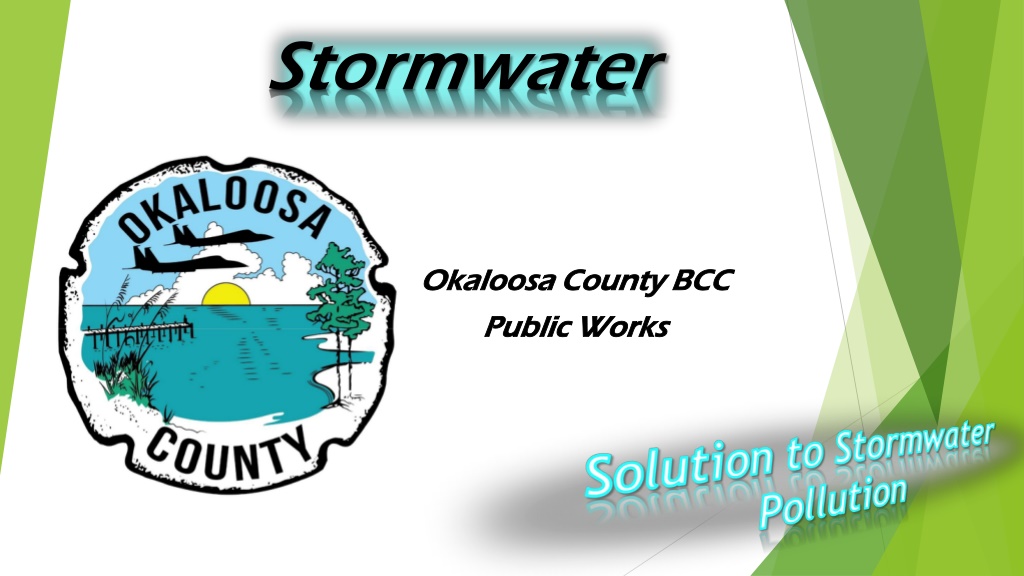Stormwater
Stormwater is excess water from rain/snow that can cause pollution if not managed properly. It can pick up pollutants and flow into water bodies, impacting the environment. Keeping stormwater clean involves individual actions like proper waste disposal, yard care, and car maintenance. Infrastructure like detention/retention ponds plays a crucial role in managing stormwater effectively.
- Stormwater management
- Pollution prevention
- Detention ponds
- Best practices
- Environmental conservation
Download Presentation
Please find below an Image/Link to download the presentation.
The content on the website is provided AS IS for your information and personal use only. It may not be sold, licensed, or shared on other websites without obtaining consent from the author. Download presentation by click this link. If you encounter any issues during the download, it is possible that the publisher has removed the file from their server.
Presentation Transcript
Stormwater Okaloosa County BCC Okaloosa County BCC Public Works Public Works
Stormwater Introduction What is stormwater? Stormwater is surface water in abnormal quantity resulting from heavy falls of rain or snow. Stormwater can soak into the soil, be stored in retention/detention ponds, evaporate back into the atmosphere, or contribute to surface runoff. Surface runoff is generated from rain and snowmelt events that flow over land or impervious surfaces, such as paved streets, parking lots, and building rooftops, and does not soak into the ground. As it flows, stormwater runoff collects and transports oil/grease, fertilizers, pesticides, and other chemicals from gardens and homes, animal waste, soil from construction sites, and other potential pollutants. Why is polluted stormwater a problem and where does it go? Why is it important to keep it clean and free of pollutants? Stormwater can pick up debris, chemicals, dirt, and other pollutants and carry them into the storm system or directly to our creeks, streams, lakes, and other bodies of water. Some stormwater systems begin with the use of channels and culverts moving excess stormwater to an inlet where it will be guided through underground pipes or other infrastructure to a pond/basin or possibly even directly into a natural waterway or wetland. This is why it is important to ensure your yard, household, and business trash is prevented from entering the stormwater system.
How to keep our stormwater clean What can you do? Reducing pollution starts with you!! Don t over-fertilize your yard Don t apply fertilizer or pesticides before a rainstorm Follow all labels when utilizing pesticides this is actually the law Never dump anything down storm drains or in streams Seed or sod bare spots in your yard Consider building a rain garden Do not blow grass, leaves and yard clippings into the street Compost your yard waste Direct downspouts away from paved areas Wash your car on the grass or take it to the car wash so the dirt and soap does not flow down the driveway and into the storm system Maintain your car so it does not leak oil and fluids and recycle your motor oil Pick up after your pets and dispose of their waste in the garbage Proper maintenance on septic systems
Types of Ponds & Infrastructure and how they work Detention/Retention Ponds/Basins: A stormwater collection location which can either retain water for long periods of time allowing it to infiltrate into the ground and evaporate or simply hold water for a short period of time before discharging the water.
Types of Ponds & Infrastructure and how they work Continued Inlets: Stormwater runs through channels, swales, culverts, or other means directing the flow of water into an inlet where it can be guided to another location.
Types of Ponds & Infrastructure and how they work Continued Major Outfalls are municipal separate storm system outfalls that discharge from a single pipe with an inside diameter of 36 inches or more or its equivalent or for municipal separate storm systems that receive stormwater from lands zoned for industrial activity (based on comprehensive zoning plans or the equivalent), an outfall that discharges from a single pipe with an inside diameter of 12 inches or more or from its equivalent.
Types of Ponds & Infrastructure and how they work Continued Swales/Channels: A stormwater conveyance channel is a permanent waterway, designed to convey stormwater runoff. The channel is lined with vegetation or riprap, or, in limited cases, gabions, which extend up the side slopes to design flow depth.
Types of Ponds & Infrastructure and how they work Continued Culverts: A culvert conveys surface water through a roadway embankment or away from the highway right-of-way (ROW) or into a channel along the ROW.
Types of Ponds & Infrastructure and how they work Continued Pipes: A conduit that conveys stormwater which is intercepted by the inlets, to an outfall where the stormwater is discharged to the receiving waters. The drainage system consists of differing lengths and sizes of pipe connected by drainage structures.
Reporting Stormwater issues in your Area Public Works Stormwater Division 1759 S. Ferdon Blvd Crestview, Florida 32536 Phone: (850) 689-5772 Phone: (850) 689-5770 Email: Roadinfo@myokaloosa.com Okaloosa County Stormwater links: Stormwater Division main page - https://myokaloosa.com/pw/stormwater Stormwater Contacts and Complaints page - https://myokaloosa.com/pw/stormwater/contacts/and/complaints Stormwater Illicit Discharges and Illegal Connections page - https://myokaloosa.com/pw/illicit/discharges Best Management Practices: Illicit Discharge Educational Outreach - https://myokaloosa.com/pw/discharge/public


